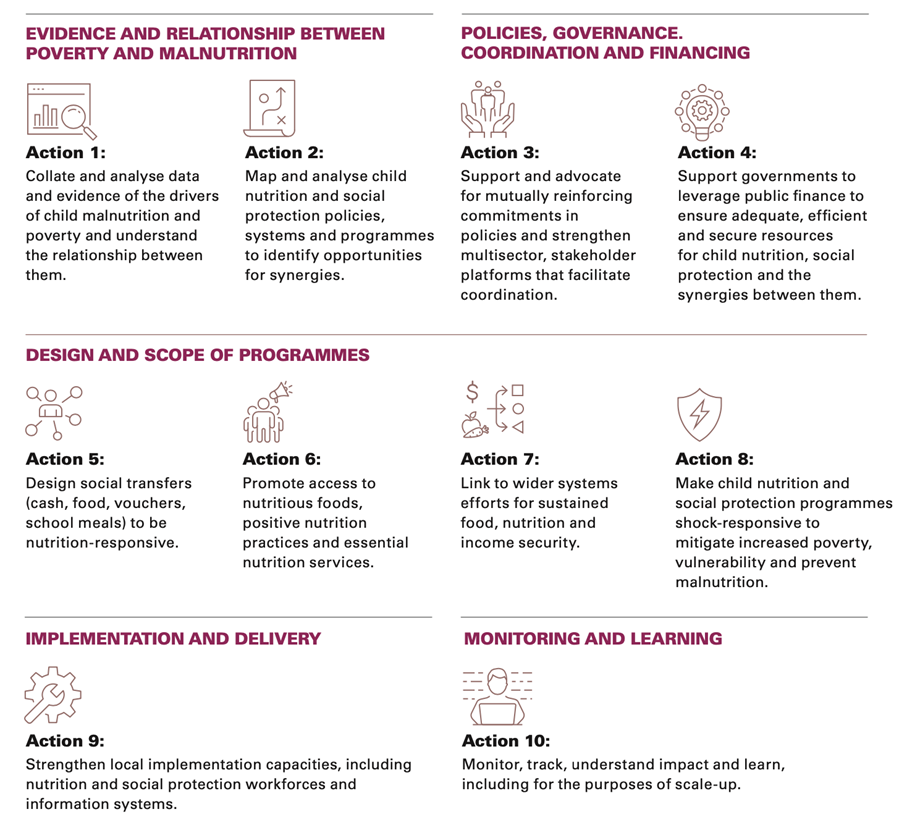Building synergies between child nutrition and social protection
This is a summary of the following report: UNICEF (2023) Building synergies between child nutrition and social protection to address malnutrition and poverty. UNICEF Programme Guidance. https://www.unicef.org/reports/building-synergies-between-child-nutrition-and-social-protection-address-malnutrition
Malnutrition in early childhood is both a cause and a manifestation of poverty, and poverty is both a cause and a consequence of malnutrition. Child malnutrition and poverty are therefore inextricably linked and should be tackled together, especially in contexts facing recurrent and multiple shocks. In many countries, interventions do not currently address the underlying drivers of child poverty and malnutrition, including the financial barriers.
There is evidence that social protection can both address child poverty and improve children’s diets by removing economic barriers to nutritious foods, increasing access to nutrition services, and preventing negative coping behaviours. Well-designed cash transfers can improve child growth, reduce wasting and stunting, and improve birthweight. The impact on child nutrition is enhanced when cash transfers are combined with evidence-based nutrition interventions, to improve access to safe and nutritious foods, positive nutrition and care practices, and essential child services. There is also evidence that school meals, which are another form of social protection, can improve nutrition outcomes for school-age children and adolescents.
UNICEF’s global nutrition and social protection technical teams designed this programming guidance to assist practitioners to support governments in intentionally developing synergies between child nutrition and social protection within their policies, systems, and programmes. Although actions and approaches to building synergies between child nutrition and social protection are context specific, this guidance proposes a set of principles and a programme framework organised around five entry points and 10 priority actions (figure 1). These actions are not listed sequentially or in order of priority; rather, their relevance and use should be determined by the context and existing opportunities.
This guidance focuses primarily on social transfers, as this is the most common entry point for synergies between child nutrition and social protection. However, synergies within other parts of the social protection system are also explored. These include social insurance (including health insurance), labour market policies (including family-friendly policies), and the social welfare services workforce. Social transfers (cash, food, food vouchers, and other in-kind transfers) may be led and resourced by governments, partners, or both. They may exist at different levels of maturity, coverage, and scale. Humanitarian cash transfers may be delivered through national systems or – where systems are unavailable, ineffective, or disrupted – directly by humanitarian actors.
Cash transfers combined with one or more complementary interventions are referred to as ‘cash plus’ programmes, which are often used as an entry point for delivering child nutrition and social protection programmes in synergy. This guidance builds on the concept of ‘cash plus’ and goes further to describe how synergies can be built between systems for sustained changes and impact at scale, including in the four systems of health, food, water and sanitation, and education.
The guidance includes examples and additional considerations that are outlined for humanitarian and fragile contexts, where government systems may be weak, overwhelmed, or disrupted. The document focuses strongly on case studies and provides references and tools alongside each action, which ensures practicality and ease of use/adaptation.
Figure 1: Actions to strengthen synergies between child nutrition and social protection



